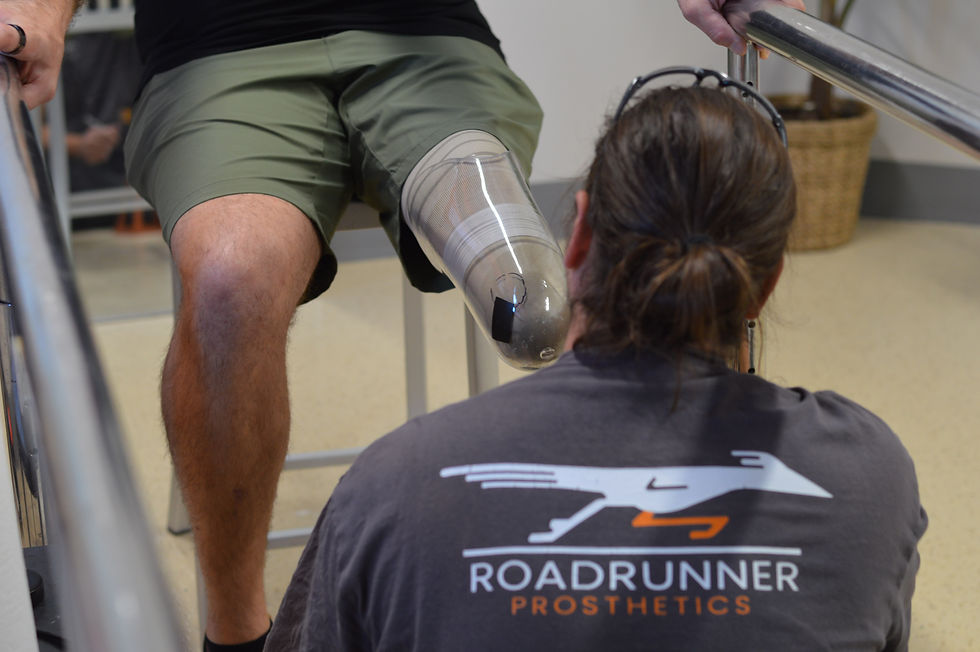When It’s Time for a New Socket or Prosthesis
- Mac Burrell
- Aug 20
- 3 min read
Let’s be honest — even the best-fitting socket doesn’t last forever.
Your body changes, your lifestyle changes, and sometimes your socket just… isn’t working like it used to. If you're starting to feel uncomfortable or unsure, it's probably time to check in.
Here’s how to tell if your socket needs a refresh, an adjustment, or a total upgrade.

First off, what exactly is the socket again?
The socket is the part of your prosthetic that your limb fits into — it’s custom-molded to fit only your limb. If the socket is not properly fit, you’ll be thrown off your comfort, alignment, and your whole experience using your prosthesis.
Think of it like shoes - when they fit right, you don’t notice them. When they don’t… you can’t think about anything but them.
Signs Your Socket Might Not Be Fitting Right Anymore
You don’t have to be in pain to need a new socket. Here are some common red flags:
Increased discomfort or pressure If you’re feeling rubbing, pinching, or soreness in new spots, your socket might not distribute pressure evenly anymore.
Frequent slipping or looseness If you feel like your prosthesis is wobbly or shifting around, it’s a sign your limb might have shrunk or changed shape.
Redness or skin irritation Some temporary redness is normal, especially right after taking your prosthesis and liner off, but if it sticks around for more than 10 minutes, it could indicate an ill fitting prosthesis, or incorrect sock ply. If you see blisters, open skin, or deep marks, your socket may need to be checked.
Changes in how you walk or move If you find yourself limping, compensating, or avoiding certain movements, the alignment of your socket might be off. Strain in your hips or lower back is usually a great indication that height or flexion angle of the prosthesis is incorrect.
Pain — anywhere Don’t ignore back, hip, or knee pain. A poorly fitting socket can throw off your whole posture and body mechanics. Pain can cause you “walk away” from discomfort which in turn while change your gait and biomechanics which could lead to compensation of other muscles. This is why sometimes you’ll feel pain in your back or hips before you realize any discomfort in your socket.
You’ve lost or gained weight Even small weight changes can affect socket fit, especially in the first year after amputation. Changes in weight will require management of sock ply, padding in the socket, or possibly a new socket.
So… how often do people get a new socket?
Everyone’s different, but here’s a general timeline:
First Year: You may need a few socket changes or adjustments as your residual limb stabilizes.
After: Most people need a new socket every 1–3 years, depending on activity level, weight changes, and wear and tear.
There’s no one-size-fits-all answer — your body tells the story.
Can it be adjusted instead of replaced?
Sometimes! If it’s a small change, like adding padding, adjusting the suspension, or sock ply, we can make tweaks in the clinic.
But if the shape of your limb has changed a lot, or your socket has worn down over time, a brand-new one may be the better call. Think long-term comfort and safety.
What if I’m not sure?
That’s what we’re here for. If something doesn’t feel right, trust your gut and give us a call. A quick visit or phone call can go a long way — and honestly, we’d rather see you early than wait until you’re dealing with pain or skin issues.
INSURANCE DISCLAIMER! Please know that insurance does not always cover a new socket just because your limb has changed. Physiological changes must be documented and justified in order for a new prosthesis to be covered under private insurance, Medicaid, and Medicare. Please talk to us or your prosthesist about our coverage, and understand your own benefits and eligibility of your specific health insurance plans.
Real Talk: You Deserve a Socket That Works for You
Living with a prosthetic is a journey, and your socket is the bridge between your body and the rest of your life. When it fits right, everything gets easier: walking, moving, living your day.
At Roadrunner Prosthetics, we’re committed to making that connection solid, comfortable, and built for wherever you’re headed next.
Need a socket check-up? Let’s get you in. Give us a call, we’ll help you figure it out, no pressure — just support.






Comments